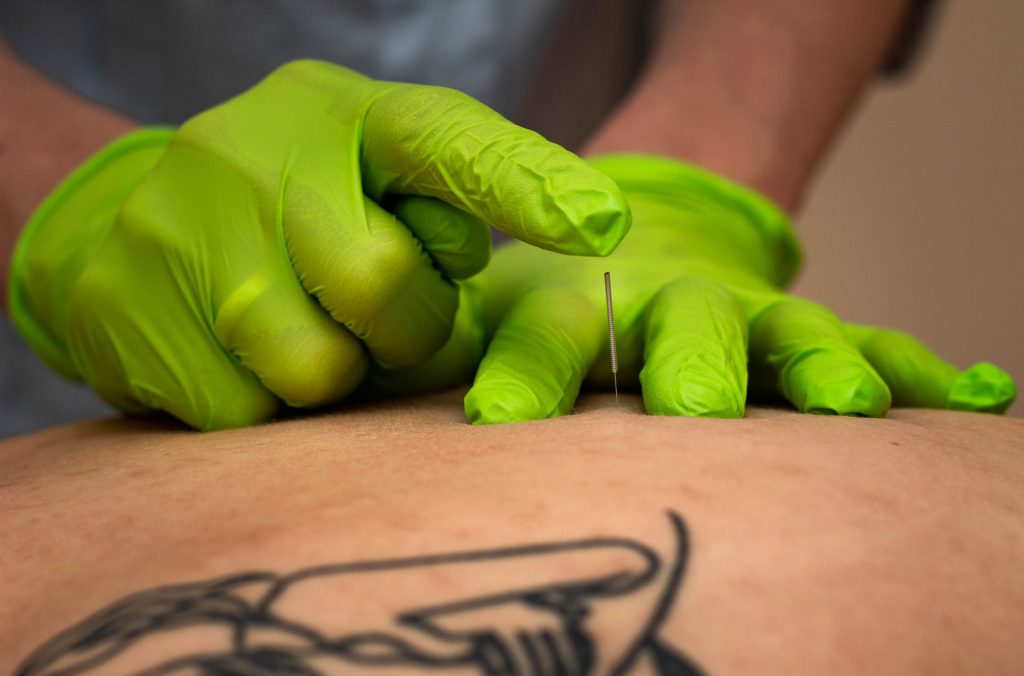Suche igłowanie – czy to skuteczna forma terapii?

Każdy z nas w bardzo indywidualny sposób reaguje na bodźce lecznicze. Jeśli dolegliwości bólowe nawracają, oprócz zastosowania klasycznych metod fizjoterapeutycznych, rozwiązaniem naszych problemów może być jedna z alternatywnych, aczkolwiek jak wskazują badania, skutecznych form terapii – suche igłowanie. Jak wynika z przeglądów systematycznych i metaanaliz z ostatnich pięciu lat (przypisy poniżej) badacze prowadzą bardzo intensywne działania w celu oszacowania efektywności i poziomu dowodów dla suchego igłowania. Jest to temat intrygujący, innowacyjny i wykazujący sporo elementów nowości.
Czym jest suche igłowanie?
Suche igłowanie to mało inwazyjna metoda terapeutyczna wykorzystująca punkcję igłową bez iniekcji substancji leczniczej. Innymi słowy to terapia, która pozwala niemal bezboleśnie przebić powierzchnię naszej skóry. Za pośrednictwem igieł nie aplikujemy substancji leczniczej, wkłucie służy nam wyłącznie do dotarcia w głąb tkanki. Autorzy licznych badań, zwracają szczególną uwagę na działanie przeciwbólowe tej techniki i nierzadko także na możliwości poprawy funkcji chorego. Doniesienia kliniczne podkreślają znaczącą przewagę metody nad grupami kontrolnymi i zabiegami pozorowanymi, co jest niezmiernie ważne dla praktyków i potwierdza skuteczność tej terapii.
Rys historyczny igłoterapii
Suche igłowanie często mylone jest z tradycyjną, wschodnią formą Akupunktury. Tradycyjna Medycyna Chińska złożona z ziołolecznictwa, masażu, akupunktury oraz systemu ćwiczeń była inspiracja dla powstania zachodniej formy igłowania. Sposoby, cele i miejsca aplikowania igieł są różne w nowoczesnym i dalekowschodnim modelu igłowania.
Znaczącym kanałem rozpowszechniania igłowania na zachodnich ziemiach był przyjazd azjatyckich emigrantów, do Stanów Zjednoczonych po II wojnie światowej. W tym czasie do Ameryki przybyło wielu azjatyckich medyków świadczących usługi takie jak kręgarstwo, masaż, akupunktura i akupresura. Szybko pozyskali uznanie wśród zachodnich pacjentów. Świat nie spieszył się jednak z popularyzacją czy legalizacją tej formy terapii. Teza, że igłowanie może być skuteczną alternatywą farmakologii, nie mogła łatwo przełamać panujących stereotypów. Z tego względu dość późno w Europie, powstały stowarzyszenia zajmujące się badaniem oddziaływania igieł na organizm.
Czy suche igłowanie pomaga?
Często jako terapeuci słyszymy to pytanie. Działanie suchego igłowania zarówno w lokalnym jak i globalnym ujęciu jest potwierdzone w licznych badaniach naukowych i zgodnych opiniach pacjentów, którym terapia pomogła uporać się z nawracającymi dolegliwościami bólowymi. Badania kliniczne jednoznacznie i jednomyślnie wskazują na istotną analgezję w stosunku do procedur pozorowanych. Analgetyczne, czyli czysto przeciwbólowe działanie punkcji igłowej tłumaczy się uwolnieniem endogennych opioidów takich jak endorfiny, enkefaliny i dynorfiny. W trakcie zabiegu terapeuta wykonuje szereg nakłuć oraz manipulacji rotacyjnych, zwiększających mikrouszkodzenie pola zabiegowego. Techniki te, powodują mikrokrwotok w obszarze punktu spustowego, aktywizując zmiany biochemiczne. Lepsze odżywienie słabo ukrwionych tkanek stymuluje procesy regeneracji i pomaga likwidować stany zapalne.
Kiedy stosować? Wskazania i przeciwwskazania do terapii igłami
Wśród wskazań do suchego igłowania możemy wymienić:
- bóle głowy o różnym pochodzeniu;
- bóle szyi i mięśni karku, zarówno te związane z siedzącym trybem życia, jak i problemy pourazowe;
- bóle barku spowodowane ograniczeniem ruchomości kończyny górnej, a także ból, który występuje z promieniowaniem do kończyny górnej;
- tendinopatie;
- bóle kręgosłupa;
- bóle dolnej części pleców, promieniujące do kończyny dolnej, na tle urazowym, przeciążeniowym i przewlekłym.
Przeciwwskazaniem do suchego igłowania są:
- chorobowe zmiany skórne;
- rany, otarcia, oparzenia, odmrożenia;
- podwyższona temperatura ciała;
- choroby zakaźne;
- nowotwory.
Jak wygląda zabieg suchego igłowania?
Terapeuta palpacyjnie znajduje miejsce w tkance pacjenta w którym zlokalizowany jest punkt spustowy. Igły pozostają w ciele pacjenta od kilku do nawet 30 minut. Fizjoterapeuta porusza igłami w różnych kierunkach, aby pogłębić penetracje i skutecznie rozbić punkt spustowy.
Druga technika zastosowania suchego igłowania, traktuje pierwotną przyczynę bólu w sposób bardziej globalny. Igły nie są wbijane bezpośrednio w bolesne miejsce, lecz dookoła tego obszaru. Metoda zakłada, że przyczyna bólu jest bardziej złożona i może dotyczyć ośrodkowego układu nerwowego.
Podsumowanie
Reasumując w większości przypadków suche igłowanie niesie z sobą efekt przeciwbólowy
i polepszający stan funkcjonalny chorych ze zmianami przeciążeniowo-zwyrodnieniowymi, choć wciąż – podobnie jak w przypadku innych zachowawczych metod leczniczych – potrzeba dalszych badań klinicznych. Niektóre publikacje wskazują, iż suche igłowanie niesie ze sobą nową jakość i może zastąpić stosowane od lat tradycyjne środki terapeutyczne jako metoda bardziej skuteczna, lecz rezultaty z części innych prac przeczą powyższemu twierdzeniu i są krytyczne wobec igłoterapii. Dlatego też najbardziej wyważone stanowisko, które zresztą ma pokrycie w większości dobrych metodologicznie randomizowanych badaniach klinicznych z ostatnich 25 trzech lat w niniejszej materii to potraktowanie suchego igłowania jako bardzo efektywnej metody przeciwbólowej pozwalającej również na poprawę czynnościową i wybrane wskaźniki jakości życia, będącej ważnym dodatkiem i cennym uzupełnieniem dotychczasowego leczenia kompleksowego.
Zapisz się na zabieg suchego igłowania w Fizjo&Well
Piśmiennictwo
1.Griswold D, Wilhelm M, Donaldson M, Learman K, Cleland J. The effectiveness of superficial versus deep dry needling or acupuncture for reducing pain and disability in individuals with spine-related painful conditions: a systematic review with metaanalysis. J Man Manip Ther. 2019 Jul; 27 (3): 128-140. 8.
2.Boyles R, Fowler R, Ramsey D, Burrows E. Effectiveness of trigger point dry needling for multiple body regions: a systematic review. J Man Manip Ther. 2015 Dec; 23 (5): 276-293.
3.Rodríguez-Mansilla J, González-Sánchez B, De Toro García Á, Valera-Donoso E, Garrido-Ardila EM, Jiménez-Palomares M, González López-Arza MV. Effectiveness of dry needling on reducing pain intensity in patients with myofascial pain syndrome: a Meta-analysis. J Tradit Chin Med. 2016 Feb; 36 (1): 1-13.
